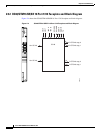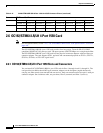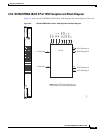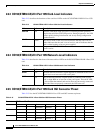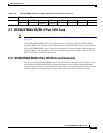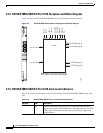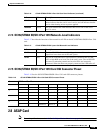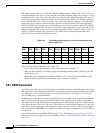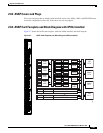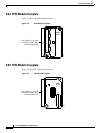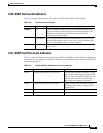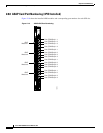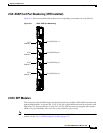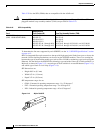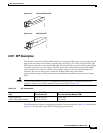
2-20
Cisco ONS 15600 Reference Manual, R7.2
Chapter 2 Card Reference
2.8.1 ASAP Connectors
The ASAP card provides up to 16 Telcordia GR-253-CORE compliant, SONET OC-3, OC-12, OC-48,
or Gigabit Ethernet ports, or up to 4 Telcordia GR-253-CORE compliant, SONET OC-192 ports, in any
combination of line rates. The ASAP card, when used with the 4-Port I/O (4PIO) module, has up to 16
physical connector adapters (known as Small Form-factor Pluggables [SFPs]). The SFP ports operate at
up to 2488.320 Mbps over a single-mode fiber. The ASAP card, when used with the 1-Port I/O (1PIO)
module, has up to 4 physical connector adapters (known as 10Gigabit Small Form Factor Pluggables
[XFPs]). The XFP ports operate at up to 9953.280 Mbps over a single-mode fiber. Both XFP and SFP
physical connector adapters have two fibers per connector adapter (transmit [Tx] and receive [Rx]). The
ASAP card supports STS-1 payloads and concatenated payloads at STS-3c, STS-6c, STS-9c, STS-12c,
STS-24c, STS-48c and STS-192c signal levels. The ASAP card is interoperable with ONS 15454
E-Series, G-Series, and ML-Series Ethernet cards.
Table 2-19 The following table gives a list of circuits supported by each
SFP on ASAP card
There are three major components to the ASAP card:
•
Carrier card, which can be installed in Slots 1 through 4 and 11 through 14
•
4PIO and 1PIO modules, also called Pluggable Input/Output Module (PIMs), which plug into the
ASAP carrier card
•
SFPs/XFPs, called Pluggable Port Modules (PPMs) in CTC, which plug into the 4PIO or 1PIO
(PIM) module and provide the fiber interface using a female LC connector
2.8.1 ASAP Connectors
An ASAP carrier card supports any combination of four 4PIOs or 1PIOs. Each 4PIO supports up to four
SFPs, while each 1PIO supports one SFP/XFP. The maximum configuration for an ASAP card is 16 SFP
or 4 XFP ports, or a mix of both. The ports can each be provisioned as either OC-3, OC-12, OC-48,
OC192 (1PIO only), or Gigabit Ethernet.
In addition, the ports can be provisioned with OC-48 dense wavelength division multiplexing (DWDM)
SFPs. 32 SFPs, each with separate product IDs (PIDs), allow operation on 32 channels, separated by
100 GHz on the ITU grid. The modules offer operation in the red band from 1546.12 to 1560.61 nm and
in the blue band from 1530.33 to 1544.53 nm. These SFPs can be used in Metro, Regional, or Long Haul
applications. Eight ASAP cards can be installed in a shelf, and up to four ITU-T SFPs can be plugged
into each of the four 4PIO/PIMs (or one XFP in the 1PIO), providing a maximum of 128 ITU-T SFPs in
a single shelf.
For detailed information about SFPs/XFPs, see the “2.8.10 SFP Modules” section on page 2-25. To
determine the line rates supported by each SFP/XFP, see the “A.3 SFP/XFP Specifications” section on
page A-12.
SFP on
ASAP STS1 STS3c STS6c STS9c STS12c STS18c STS24c STS36c STS48c
STS192
c
OC3 x x
OC12xxxxx
OC48xxxxxxxxx
OC192xxxxxxxxxx



